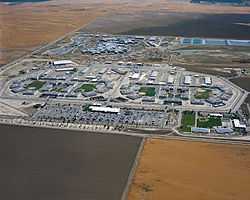Prisons in California
The California State Prison System is administered by the California Department of Corrections and Rehabilitation Division of Adult Institutions. which had 136,000 inmates as of 2014.[1]
Background
The California system has been the origin of many trends in prison conditions within the United States as a whole. The state's large and diverse population, large size, large urban areas, high rates of violent crime, criminal street gangs, tough sentencing laws and its status as an entry point to the U.S. for both immigrants and drugs has given California a large and complex prison environment. California prisons are overcrowded, with a number of facilities holding more than 200% of their design capacity.
The system, like the state as a whole, lacks a racial/ethnic majority among the population, with Hispanic inmates making up approximately 37% of the population, African American and white inmates each representing about 27%, and other inmates representing 8% as of 2006. Prisoner identification and affiliation is tied closely to race and region of the state, which has contributed to tension and violence. There has been a long running racial tension between African American and Southern Mexican American prison gangs and significant riots in California prisons where Mexican inmates and African Americans have targeted each other particularly, based on racial reasons.[2] California is the birthplace of the United States' most powerful and well-known prison gangs, including the Aryan Brotherhood, Mexican Mafia, Nuestra Familia, and the Black Guerrilla Family. State efforts against these gangs made California a pioneer in the development of Security Housing Unit "supermax" control-unit facilities.
The overcrowded conditions and accusations of inadequate medical facilities and mistreatment have caused the federal courts to intervene in the system's operation since the 1990s, appointing special oversight and enforcing consent decrees over the system's medical system and the SHU units and capping populations at several facilities. As of 2007, by order of federal courts, the system's medical system is under federal receivership, and a federal court may impose a mandatory limit on the system's total population by June 2007.
Prison growth and overcrowding

From 1982 to 2000, California's prison population increased 500%. To accommodate this population growth, the state of California built 23 new prisons at a cost of 280 million to 350 million dollars apiece. California's prisons are public and are financed by the Public Works Department and operated by the California Department of Corrections and Rehabilitation. The state funds the prison system's annual costs. In 2005 the state rate of incarceration was 616 per 100,000 adults, or about .6%.

Of the 160,000 prisoners in California, two-thirds are African-American and Latino. Approximately 17% were born abroad. Most prisoners come from California's high density population areas, however incarceration rates in less populated areas are higher than from more congested areas. About 62% of inmates in 2005 were sentenced from Southern California. The largest racial group in California prisons was whites from 1980 to 1986, blacks from 1986 to 1992, and Hispanics from 1992 to the present.[3]
The California Prison Industry Authority provides the inmates themselves with productive job opportunities. The inmate work program's main aim is to rehabilitate prisoners and promote their successful re-entry into society after their punishment has been completed. Through the program, approximately 5,900 inmates are given work assignments in 60 different lines of work at 22 California prisons. The goods produced by the inmates are available for local, state, and federal governmental agencies. Prisoners are able to earn between 30 and 95 cents per hour of work.
Supreme Court verdict on unconstitutional conditions
In 2011, the Supreme Court ruled in a 5-4 decision in Brown v. Plata that overcrowded conditions in California prisons constituted a violation of the Eighth Amendment, which bans cruel and unusual punishments.[4] The decision upheld a lower court decision which found that "an inmate in one of California’s prisons needlessly dies every six or seven days due to constitutional deficiencies."[4] The Court found that, at the time of the lower court trial, California jailed nearly twice as many prisoners as its prisons were designed to hold.[5] In the majority opinion for the Supreme Court, Justice Anthony Kennedy wrote:
After years of litigation, it became apparent that a remedy for the constitutional violations would not be effective absent a reduction in the prison system population or expanded facilities.
Prison Spending
7% of California's budget was spent on corrections during Fiscal Year 2013-2014.[6]
See also
- List of California state prisons
- Three-strikes law: Effects in California
- Prisons in the United States
References
- ↑ CDCR Population Report, October 1, 2014
- ↑ Racial segregation continues in California prisons
- ↑
- ↑ 4.0 4.1 Liptak, Adam (23 May 2011). "Justices, 5-4, Tell California to Cut Prisoner Population". The New York Times. Retrieved 15 July 2013.
- ↑ "Brown, Governor of California, et al. v. Plata et al.". Supreme Court of the United States. May 2011. Retrieved 15 July 2013.
- ↑ California Budget 2014-2015
External links
| Wikimedia Commons has media related to Prisons in California. |
